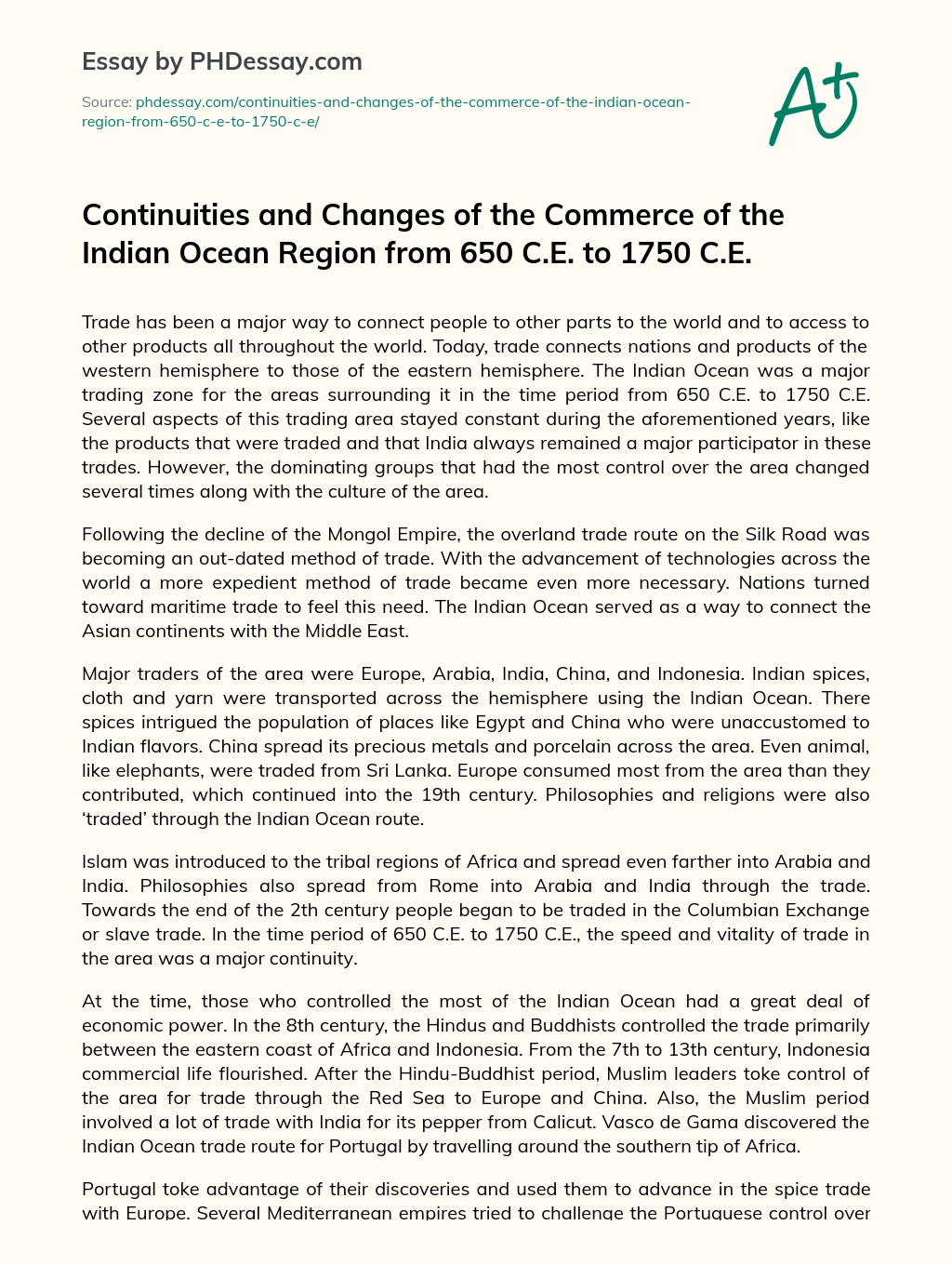Analyze the Changes and Continuities in Commerce
Trade has been a major way to connect people to other parts to the world and to access to other products all throughout the world. Today, trade connects nations and products of the western hemisphere to those of the eastern hemisphere. The Indian Ocean was a major trading zone for the areas surrounding it in the time period from 650 C.E. to 1750 C.E. Several aspects of this trading area stayed constant during the aforementioned years, like the products that were traded and that India always remained a major participator in these trades. However, the dominating groups that had the most control over the area changed several times along with the culture of the area.
Following the decline of the Mongol Empire, the overland trade route on the Silk Road was becoming an out-dated method of trade. With the advancement of technologies across the world a more expedient method of trade became even more necessary. Nations turned toward maritime trade to feel this need. The Indian Ocean served as a way to connect the Asian continents with the Middle East.
Major traders of the area were Europe, Arabia, India, China, and Indonesia. Indian spices, cloth and yarn were transported across the hemisphere using the Indian Ocean. There spices intrigued the population of places like Egypt and China who were unaccustomed to Indian flavors. China spread its precious metals and porcelain across the area. Even animal, like elephants, were traded from Sri Lanka. Europe consumed most from the area than they contributed, which continued into the 19th century. Philosophies and religions were also 'traded' through the Indian Ocean route.
Order custom essay Continuities and Changes of the Commerce of the Indian Ocean Region from 650 C.E. to 1750 C.E. with free plagiarism report
GET ORIGINAL PAPER
Islam was introduced to the tribal regions of Africa and spread even farther into Arabia and India. Philosophies also spread from Rome into Arabia and India through the trade. Towards the end of the 2th century people began to be traded in the Columbian Exchange or slave trade. In the time period of 650 C.E. to 1750 C.E., the speed and vitality of trade in the area was a major continuity.
At the time, those who controlled the most of the Indian Ocean had a great deal of economic power. In the 8th century, the Hindus and Buddhists controlled the trade primarily between the eastern coast of Africa and Indonesia. From the 7th to 13th century, Indonesia commercial life flourished. After the Hindu-Buddhist period, Muslim leaders toke control of the area for trade through the Red Sea to Europe and China. Also, the Muslim period involved a lot of trade with India for its pepper from Calicut. Vasco de Gama discovered the Indian Ocean trade route for Portugal by travelling around the southern tip of Africa.
Portugal toke advantage of their discoveries and used them to advance in the spice trade with Europe. Several Mediterranean empires tried to challenge the Portuguese control over the Persian Gulf however, by the 16th century they had established bases in the area. Shortly following that, the English and Dutch began placing officials in India and Africa in order to farther their own endeavors.
From the 7th to 18th century many things about the commercial life in the region of the Indian Ocean stayed constant however, many things were altered. After the potential of the Indian Ocean trade system began known, more and more countries began to enter into a power struggle for the control over the area. Precious metals, Indian spices, and exotic animals contributed to the reasons why so many explorers, mariners and traders were so intrigued by the prospects of trading in the Indian Ocean.

Did you know that we have over 70,000 essays on 3,000 topics in our database?
Cite this page
Explore how the human body functions as one unit in harmony in order to life
summerslichannoosee.blogspot.com
Source: https://phdessay.com/continuities-and-changes-of-the-commerce-of-the-indian-ocean-region-from-650-c-e-to-1750-c-e/
0 Response to "Analyze the Changes and Continuities in Commerce"
Post a Comment